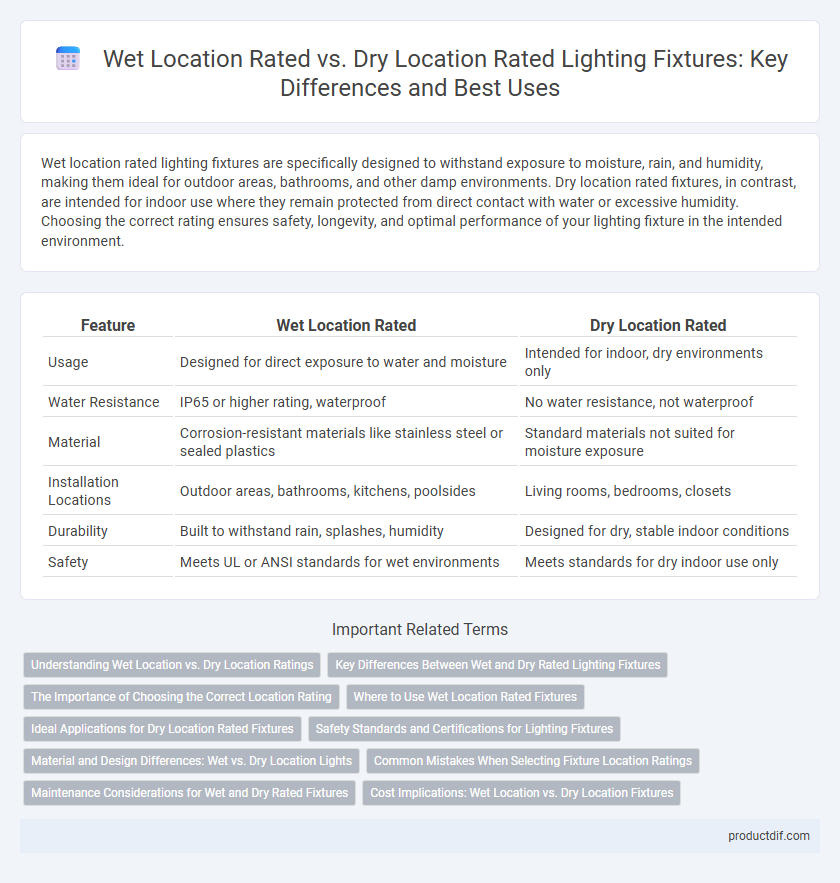Wet location rated lighting fixtures are specifically designed to withstand exposure to moisture, rain, and humidity, making them ideal for outdoor areas, bathrooms, and other damp environments. Dry location rated fixtures, in contrast, are intended for indoor use where they remain protected from direct contact with water or excessive humidity. Choosing the correct rating ensures safety, longevity, and optimal performance of your lighting fixture in the intended environment.
Table of Comparison
| Feature | Wet Location Rated | Dry Location Rated |
|---|---|---|
| Usage | Designed for direct exposure to water and moisture | Intended for indoor, dry environments only |
| Water Resistance | IP65 or higher rating, waterproof | No water resistance, not waterproof |
| Material | Corrosion-resistant materials like stainless steel or sealed plastics | Standard materials not suited for moisture exposure |
| Installation Locations | Outdoor areas, bathrooms, kitchens, poolsides | Living rooms, bedrooms, closets |
| Durability | Built to withstand rain, splashes, humidity | Designed for dry, stable indoor conditions |
| Safety | Meets UL or ANSI standards for wet environments | Meets standards for dry indoor use only |
Understanding Wet Location vs. Dry Location Ratings
Wet location rated lighting fixtures are specifically designed to withstand direct exposure to water, rain, and extreme humidity, making them suitable for outdoor environments like patios, pools, and gardens. Dry location rated fixtures, by contrast, are intended for indoor use only, where they are protected from moisture, ensuring safe operation in areas such as living rooms or bedrooms. Selecting the appropriate rating ensures durability, safety, and compliance with electrical codes in various environmental conditions.
Key Differences Between Wet and Dry Rated Lighting Fixtures
Wet location rated lighting fixtures are designed to withstand direct exposure to water, humidity, and harsh weather conditions, making them suitable for outdoor or highly damp areas. Dry location rated fixtures are intended for indoor use in environments protected from moisture, offering no resistance to water or condensation. Key differences include the materials used, sealing methods, and safety certifications, ensuring wet location rated fixtures provide enhanced durability and protection in challenging environments.
The Importance of Choosing the Correct Location Rating
Selecting the correct location rating for lighting fixtures is crucial to ensure safety and longevity, as wet location rated fixtures are specifically designed to withstand water exposure, moisture, and humidity. Dry location rated fixtures are intended for indoor use where exposure to dampness or water is minimal, preventing electrical hazards and damage. Using the appropriate rating prevents corrosion, electrical failures, and guarantees compliance with building codes and safety standards.
Where to Use Wet Location Rated Fixtures
Wet location rated lighting fixtures are designed for direct exposure to water, making them ideal for outdoor areas such as patios, pool sides, and garden pathways where they can withstand rain, snow, and humidity. These fixtures comply with strict UL or IP ratings, ensuring safety and durability in environments subject to moisture and water spray. Using wet location rated fixtures in areas constantly exposed to wet conditions prevents electrical hazards and extends the lifespan of the lighting installation.
Ideal Applications for Dry Location Rated Fixtures
Dry location rated lighting fixtures are ideally suited for indoor environments such as living rooms, bedrooms, offices, and other areas protected from moisture and humidity. These fixtures offer optimal performance in spaces with stable temperature and low exposure to water, preventing electrical hazards and corrosion. Common applications include ceiling lights, wall sconces, and table lamps used in dry, climate-controlled settings.
Safety Standards and Certifications for Lighting Fixtures
Wet location rated lighting fixtures comply with safety standards such as UL 1598 and NEC Article 410.10(D), ensuring they withstand direct exposure to water and moisture without electrical hazards. Dry location rated fixtures meet standards suitable only for indoor, protected environments, lacking the necessary certifications for water resistance and increased safety in damp conditions.
Material and Design Differences: Wet vs. Dry Location Lights
Wet location rated lighting fixtures feature corrosion-resistant materials such as stainless steel, rubber gaskets, and sealed enclosures to prevent water ingress, ensuring durability in damp or submerged environments. Dry location lights typically use less robust materials like standard metals and plastics, with open or vented designs suitable only for indoor, moisture-free areas. The distinct design differences prioritize waterproof seals and sturdy construction in wet-rated fixtures, contrasting with simpler, ventilation-focused designs in dry-rated options.
Common Mistakes When Selecting Fixture Location Ratings
Choosing a lighting fixture rated for dry locations in wet or damp environments can lead to electrical hazards and premature fixture failure. Wet location rated fixtures are specifically designed with sealed housings and corrosion-resistant materials to withstand moisture exposure. Failing to match fixture ratings to environmental conditions compromises safety and voids manufacturer warranties.
Maintenance Considerations for Wet and Dry Rated Fixtures
Wet location rated lighting fixtures require materials and seals designed to prevent moisture ingress, significantly reducing maintenance frequency and costs in outdoor or damp environments. In contrast, dry location rated fixtures lack these protective features, making them unsuitable for exposure to humidity or water and prone to faster degradation and frequent servicing. Properly selecting wet rated fixtures for moist conditions ensures longevity and lowers the risk of electrical hazards and corrosion-related repairs.
Cost Implications: Wet Location vs. Dry Location Fixtures
Wet location rated lighting fixtures incur higher initial costs due to specialized sealing and materials designed to withstand moisture, corrosion, and extreme weather conditions. Dry location rated fixtures offer a more affordable option but are unsuitable for outdoor or damp environments, potentially leading to higher replacement and maintenance expenses if misused. Investing in wet location rated fixtures ensures durability and compliance with safety standards, ultimately reducing long-term costs in wet or humid settings.
Wet location rated vs dry location rated Infographic

 productdif.com
productdif.com